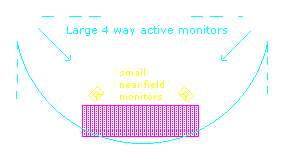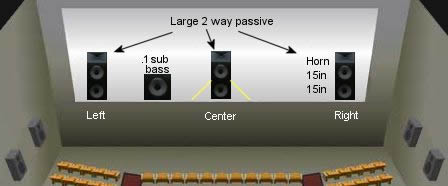
Monitors. The supposed purpose of a small low-fidelity monitoring system is for the engineer to hear an approximation of small domestic sound systems. This argument is described by many older recording engineers as flawed, including myself. Without the reference of a large full scale active monitor system to hear what the EQ is actually doing, the major problem of inconsistencies between musical recordings will remain.
Bob Katz - The Secret of The Mastering Engineer "Mastering engineers have long ago learned that the widest-range, most accurate loudspeakers translate to the widest variety of alternate playback systems".
"Loudspeakers are the single most important element. They influence the art as it is being created. And in that process loudspeakers need to be neutral. If they are not neutral then they become part of the art." as stated in October 2014 by Dr. Floyd E. Toole (Vice President Acoustical Engineering, Harman International Industries, Inc.) Sound Reproduction: the State of our Science.
Many recording engineers waste endless hours caught in a "Circle of Confusion" by trying to evaluate the sound quality of speaker system "A" by listening to it with a coloured recording that was created by compensating for the limitations of speaker system "B", as defined by Dr. Floyd E. Toole in his book "Sound Reproduction Loudspeakers and Rooms".

The extreme of this problem is for cinemas (Academy characteristic) compensating for the larger, mostly low-fidelity 2-way cinema speakers, plus high frequency screen attenuation and cinema room acoustics. When the recorded music is played back on a full fidelity active sound system, the harshness created by excessive EQ (compensating for the cinema requirement) can be audibly annoying.
Unfortunately the majority of EQ and compression in pop recording is used to compensate for limitations of the small studio monitors, often without the recording engineer being aware. Small 2-way monitors and domestic speaker systems are referenced at 1 Watt with a static tone sweep at close range, and become distorted as the power increases. This problem is never mentioned in the technical specs of the monitors. Most recording engineers experience listening fatigue without understanding this cause.
Many pop recording engineers have a religious belief in marketing hype and a romantic attachment to brand names. The failure to have a proper understanding of basic electro-acoustic principles (physics of loudspeakers) and the belief that 'technical knowledge' is not relevant is the primary cause of the problem.
Polar Response 2-way small speaker systems are the majority, and have wide dispersion at low frequencies, and narrow beaming dispersion at high frequencies. This problem becomes worse as the power increases.
The small woofer
Below middle C a small bass speaker cannot effectively couple to the air. As the power increases with deep bass notes, the cone over modulates and flaps at the limit of exertion. The bass notes do not increase with level and begin to acoustically compress. The excessive woofer cone exertion causes the mid to be muddled (inter-modulation).

The tweeter
Tweeters do not compress with power and increase in level until destruction without warning. 8in cone speakers (woofers) become distorted above 1kHz (lobing distortion). The tweeter is often crossed over at a lower frequency than it is designed for, between 2k - 3kHz. Most tweeters are designed to give correct performance above 5kHz (not 2kHz). This is not a problem below 1 Watt, where the tweeter is not stressed, but at higher power many dome tweeters generate extreme 2nd harmonic distortion as a result of the lower crossover frequency.

Inter-modulation Linearity and Intelligibility. Muddle-ness and inter-cluttering within the music, difficulty to discern detail, caused by interference within speaker components. Lobe and node distortion is caused by secondary vibrations and chaotic resonances within the speaker cone at higher power sounding harsh and screechy.
Dynamic power response is the ability for the sound fidelity to remain intact between low and high power for dynamic range. It is not possible for small 2-way monitors or small domestic speakers to achieve this accurately. The majority of sound systems are passive, due to cost and the fashion for systems to be small.
For a monitor speaker system to sound consistent and accurate at all power levels it must be 3 - 4 way active (with 15in bass speakers). Each speaker driven by its own amplifier, and matched in efficiency, power and dispersion.
The closing comment for this page is to bring awareness to a recording industry that has historically placated to mixing music suited to small low fidelity speakers. This over compressed material should be freely available on the internet reflecting its true value. For the recording industry to mature and take its place in the digital world, it needs to let go of the past, and make available to the world full fidelity recordings that are best heard on large scale active sound systems.


